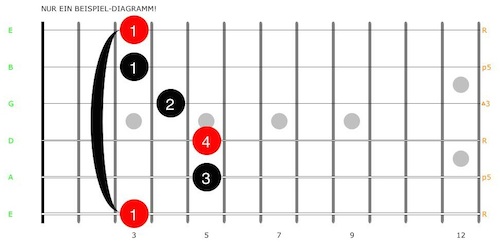What are chord diagrams?
No, you can’t eat them! : P
There are different types of diagrams. Aside from being incredibly useful for getting a quick idea of a chord, etc., they’re also easy to remember because you don’t have to memorize any notes or Intervals.
There are several variations of diagrams for the guitar.
Chord diagrams in songs / sheet music
This variant with the chords directly in the notation is very clear and you can explain even theVoicingeasily and quickly.
The fingers are marked below the diagrams.
So number 1 means that this string / fret should be pressed with the index finger. Number 2 with the middle finger, etc.

If these diagrams did not exist, the tabs would look like this:

Or even worse; with notes!

It goes without saying that it won’t always be that difficult to understand. Over time you get used to theTabs and also to the notes.
So it is not necessarily a bad thing to learn these chords by heart as quickly as possible in order to get an „idea“ of the tabs or the notes.
Arpeggio diagrams
It doesn’t always have to be chords that can be written down on diagrams. You also write down scales and arpeggios with diagrams.
Please note that scales and arpeggios are not played together. Well, our five fingers wouldn’t be enough to play one scale at the same time, but it wouldn’t work from a guitar-technical point of view either.

It should be noted that we start from the root note (the red „R“) and then move to the right. As soon as a string shows no more notes, you can go to the next string and start again from the left.
Without the diagram, the C Major 7 Arpeggio would look like this.

Scales diagrams
Now for the last part: The Scales .
Scales can also be displayed as a diagram.
The principle is the same again. We start from the very bottom left (which is the lowest string on the guitar).
Then we move to the right and as soon as there is no more note on that string, we go to the next string and start again from the left.
Pay attention, that the tone should go from low to high. If this is not the case, you are probably starting on the wrong string.

Thanks to this diagram we are kept from further calamities such as Notes protected:

I know it's funny to talk badly about grades. Nevertheless, sooner or later you should think about learning to read notes. :)
How do I read charts?
Normally, diagrams have a very simple structure.
You just have to know – as always – how and from where to read it.
Here some examples;

In this example we have a guitar fretboard diagram.
On the far left (in green) are the names of the empty / open strings.
The diagram is upside down. Pay attention to the thickness of the strings. The lowest string (which makes the lowest sound) is the thickest string.
Empty / open string chords

In this chord diagram we see an A minor chord. The low E string (at the bottom of the diagram) shouldn’t be played. That is why it is marked with an „X“.
The red notes with the „R“ are Root Notes.
In an A minor chord like this example, the the Root Note would be „A“.
Barre chords

The black bar at the beginning of a chord means that you have to press down all the strings with your index finger of your left hand.
Thischordis then called „ Barre chord „.
Arpeggios

As explained briefly at the beginning, we start with an arpeggio on the far left at the root note.
In this example we start in the 3rd fret on the A string.
Then we move to the right (to the third) and then jump to the next string. We always try to „finish“ one string first before jumping to the next one.
Of course, you don’t have to play in sequence when you improvise or write songs. It’s just about the exercise as such.
Scales

With the scales, too, we start on the root note and move to the right until there are no more notes on this string.
Support me on Patreon and get the original Videos, PDFs, Guitar Pro Files and Neck Diagram for each Post!


Keine Kommentare